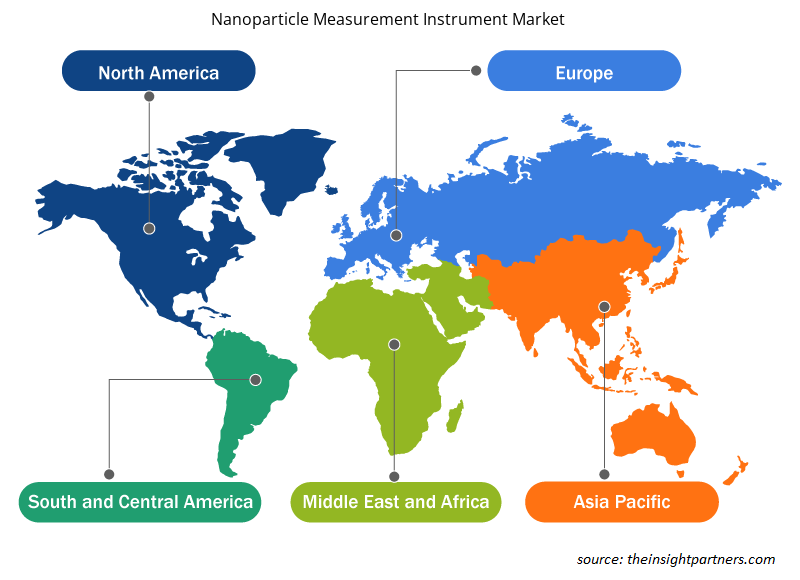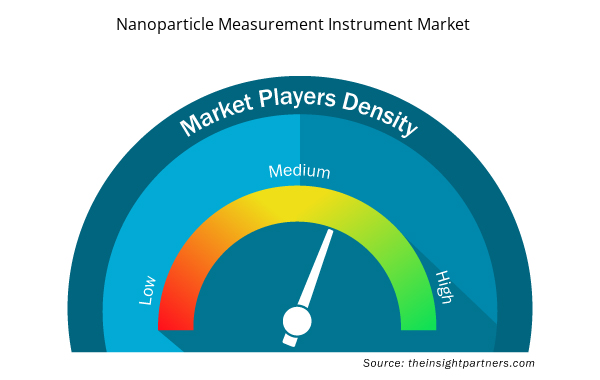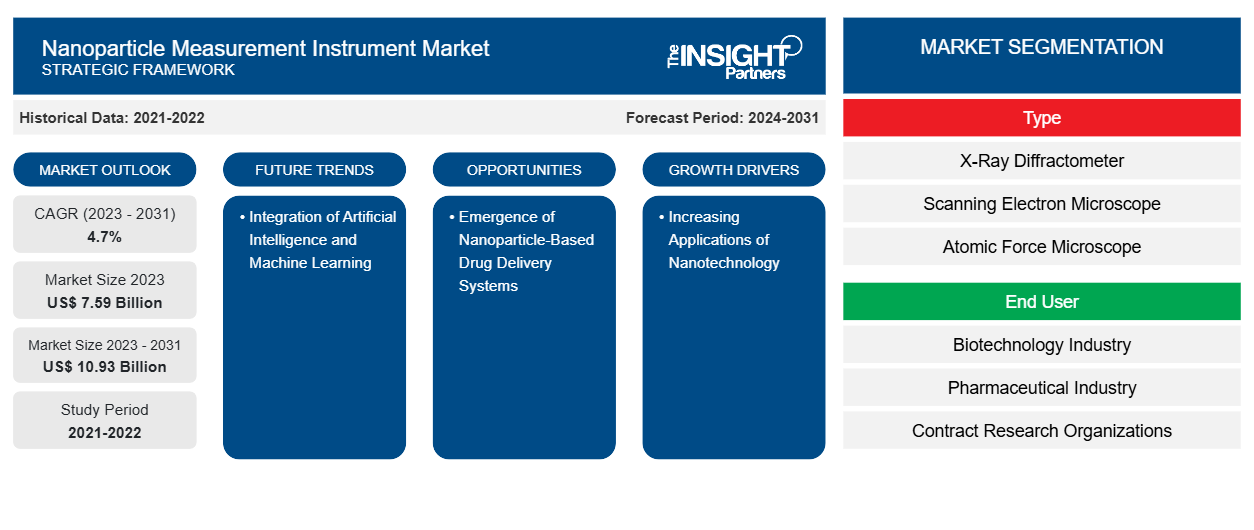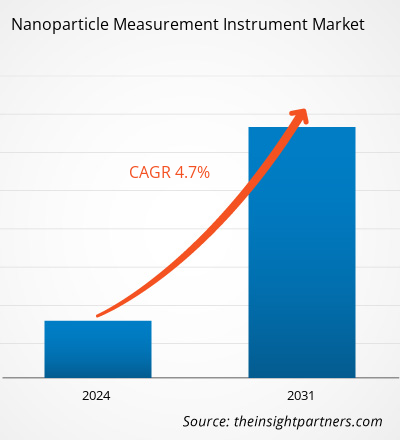纳米颗粒测量仪器市场规模预计将从 2023 年的 75.9 亿美元增至 2031 年的 109.3 亿美元。预计 2023-2031 年期间该市场的复合年增长率为 4.7%。人工智能和机器学习的融合很可能成为市场未来的趋势。
纳米颗粒测量仪器市场分析
纳米技术的应用范围不断扩大,分析技术的发展也推动着纳米粒子测量仪器市场 的增长。纳米粒子是直径在 1 至 100 纳米之间的小粒子。透射电子显微镜 (TEM)、扫描电子显微镜 (SEM)、原子力显微镜 (AFM) 和 X 射线衍射仪等仪器用于测定粒子浓度和粒子大小。它们还用于动态光散射和显微镜等技术。近年来,纳米粒子因其在消费品、医药、土壤和水生环境中的应用而备受关注,这意味着需要仪器来测量其尺寸并研究其特性。
纳米颗粒测量仪器市场概况
预计在预测期内,中国将在亚太地区纳米粒子测量仪器市场中实现最高的复合年增长率。北京的国家电子显微镜中心和清华大学的国家蛋白质科学中心等知名研究机构,以及私营公司的研究设施(例如位于中国上海的赛默飞世尔科技电子显微镜设施)的存在,为中国市场规模做出了贡献。这些研究机构利用先进的分析仪器,如 SEM、TEM 和 XRD 来了解纳米粒子的结构。此外,公司、组织、政府等正在促进利用纳米粒子的研究活动增加以及纳米粒子在中国制药行业的应用不断扩大。因此,医疗保健领域的此类活动促进了中国纳米粒子测量仪器市场的增长。
定制此报告以满足您的需求
您可以免费定制任何报告,包括本报告的部分内容、国家级分析、Excel 数据包,以及为初创企业和大学提供优惠和折扣
- 获取此报告的关键市场趋势。这个免费样品将包括数据分析,从市场趋势到估计和预测。
纳米颗粒测量仪器市场驱动因素和机遇
纳米技术的应用不断扩大,推动市场增长
纳米技术在制药行业中的应用越来越多,包括癌症治疗、靶向药物输送和诊断成像。使用纳米粒子作为药物输送载体有助于提高治疗药物的疗效并降低副作用。纳米药物是在纳米尺度上操纵的材料,通常用于生产具有增强生物利用度、控制释放特性或靶向性的药物。这些应用需要精确的测量设备来监测药物输送、确保质量控制和表征纳米粒子。彻底了解和控制纳米粒子的尺寸、形状、表面电荷和成分对于开发纳米药物是必不可少的。因此,zeta 电位分析仪、电子显微镜和尺寸分析仪对于与纳米粒子相关的研究至关重要。纳米药物可以确保药物精确输送到特定的组织或细胞,同时提高其稳定性和溶解度。纳米技术领域的持续研究和优化工作依赖于复杂的测量工具,以了解和改变纳米尺度上的相互作用和特性。因此,纳米技术在生产纳米药物中的应用增加正在推动全球纳米颗粒测量仪器市场的增长。
纳米粒子药物输送系统的出现为市场提供了机遇
目前,人们正在开展多项利用纳米技术进行药物输送的研究活动。纳米技术通过在人体中以位点为导向和靶向的方式精准输送药物,大大提高了慢性病治疗的有效性和效力。人们已经研究了各种纳米药物在化学疗法和免疫疗法中的应用。最近,人们致力于推进纳米药物输送系统和纳米药物,重点是利用纳米材料的功效和选择性来改善药物输送。在药物输送中使用大尺寸材料带来了巨大的挑战,包括生物利用度差、体内不稳定、溶解度差、靶向输送问题以及体内吸收不佳。纳米技术在先进的药物/药物配方中发挥着重要作用,因为它们的尺寸、形状和表面化学性质可以进行调整,从而从纳米级材料和结构的独特性质中获益;这允许根据不同的生物医学应用定制它们的功能。例如,阿斯利康正在研究脂质纳米颗粒 (LNP),作为一种新型且有前景的核苷酸药物输送系统,可在靶细胞内产生治疗性蛋白质。Creative Biolabs 为 API 提供复杂的配方开发系统。其粒子和纳米粒子工程技术使一系列基于纳米技术的药物输送平台成为可能。该公司还销售聚合物纳米颗粒、脂质体和纳米晶体。因此,基于纳米技术的药物输送系统的不断发展预计将在未来几年为纳米颗粒测量仪器市场带来重大机遇。
纳米颗粒测量仪器市场报告细分分析
有助于得出纳米颗粒测量仪器市场分析的关键部分是产品和类型、应用和最终用户。
- 根据类型,纳米颗粒测量仪器市场细分为 X 射线衍射仪、扫描电子显微镜、原子力显微镜、光子相关光谱仪、纳米颗粒表面积监测仪、透射电子显微镜、凝聚粒子计数器、差分迁移率分析仪、扫描迁移率粒度仪、纳米颗粒跟踪分析仪、气溶胶颗粒质量分析仪等。透射电子显微镜部分在 2023 年占据了最大的市场份额。
- 根据最终用户,市场分为制药行业、生物技术行业、合同研究组织等。制药行业在 2023 年占据了最大的纳米颗粒测量仪器市场份额。
纳米颗粒测量仪器市场份额按地区分析
纳米颗粒测量仪器市场报告的地理范围主要分为五个区域:北美、亚太地区、欧洲、南美和中美以及中东和非洲。2023 年,北美占据了市场主导地位。该地区市场的增长归因于提供纳米颗粒测量仪器的公司越来越多、纳米技术在制药和生物技术行业的商业化以及医疗器械行业研发活动的增加。近年来,纳米颗粒在各种临床应用(包括疾病诊断和治疗)方面的开发取得了重大进展。例如,当以越来越专业的方式设计脂质基、聚合物和无机纳米颗粒时,这些颗粒可以广泛优化以个性化方式进行药物输送;这开启了精准医疗时代。由于纳米颗粒在医疗保健领域的这些新兴应用,美国各公司正在推出先进的仪器来分析纳米颗粒。例如,2023 年 7 月,JEOL USA, Inc. 在明尼阿波利斯举办的显微镜和微分析 (M&M) 展览会上推出了两款新型 SEM 仪器。JSM-IT710HR SEM 是一款紧凑、多功能的肖特基场发射 SEM,非常适合高分辨率需求。此外,JSM-IT210 InTouchScope SEM 为新操作员提供了简单、自动化的工作流程。这些 SEM 采用了 JEOL 智能技术,操作简单;快速、高分辨率成像;以及各种标本分析,包括孔雀羽毛、石灰石颗粒和聚合物。
纳米颗粒测量仪器市场区域洞察
Insight Partners 的分析师已详细解释了预测期内影响纳米颗粒测量仪器市场的区域趋势和因素。本节还讨论了北美、欧洲、亚太地区、中东和非洲以及南美和中美洲的纳米颗粒测量仪器市场细分和地理位置。

- 获取纳米颗粒测量仪器市场的区域特定数据
纳米颗粒测量仪器市场报告范围
| 报告属性 | 细节 |
|---|---|
| 2023 年的市场规模 | 75.9亿美元 |
| 2031 年市场规模 | 109.3亿美元 |
| 全球复合年增长率(2023 - 2031) | 4.7% |
| 史料 | 2021-2022 |
| 预测期 | 2024-2031 |
| 涵盖的领域 | 按类型
|
| 覆盖地区和国家 | 北美
|
| 市场领导者和主要公司简介 |
|
纳米颗粒测量仪器市场参与者密度:了解其对业务动态的影响
纳米颗粒测量仪器市场正在快速增长,这得益于终端用户需求的不断增长,这些需求源于消费者偏好的不断变化、技术进步以及对产品优势的认识不断提高等因素。随着需求的增加,企业正在扩大其产品范围,进行创新以满足消费者的需求,并利用新兴趋势,从而进一步推动市场增长。
市场参与者密度是指在特定市场或行业内运营的企业或公司的分布情况。它表明在给定市场空间中,相对于其规模或总市场价值,有多少竞争对手(市场参与者)存在。
在纳米颗粒测量仪器市场运营的主要公司有:
- 布鲁克公司
- Spectradyne有限责任公司
- 马尔文帕纳科有限公司
- IZON 科学有限公司
- Particle Metrix GmbH,
- Microtrac Retsch GmbH,
免责声明:上面列出的公司没有按照任何特定顺序排列。

- 获取纳米颗粒测量仪器市场顶级关键参与者概述
纳米颗粒测量仪器市场新闻和最新发展
纳米颗粒测量仪器市场通过收集一手和二手研究后的定性和定量数据进行评估,其中包括重要的公司出版物、协会数据和数据库。以下列出了市场中的一些发展情况:
- Malvern Panalytical 推出了 Zetasizer 样品助手,这是其 Zetasizer Advance 系列光散射仪器的新配件。此次升级使 Zetasizer Advance 用户每天能够生成更多数量的粒度、zeta 电位和粒子浓度测量值,同时减少监督需求。这种自动化程度的提高提高了靶向药物输送和病毒载体研究的生产力和可靠性。(来源:Malvern Panalytical,公司网站,2024 年 4 月)
- 布鲁克宣布推出 JPK NanoWizard V BioAFM,这是一种新颖的系统,标志着自动化的里程碑,并有助于生命科学原子力显微镜研究的易用性。NanoWizard V 是一种快速、自动化的 BioAFM,可与先进的光学显微镜完全集成。它能够对从亚分子水平到细胞和组织水平的各种尺寸的样品进行快速、定量的机械测量和动力学分析。系统参数的自动设置、对齐和重新调整为长期、自调节的机械生物动力学实验开辟了新的可能性。(来源:布鲁克,公司网站,2021 年 12 月)
纳米颗粒测量仪器市场报告覆盖范围和交付成果
“纳米颗粒测量仪器市场规模和预测(2021-2031)”报告对以下领域进行了详细的市场分析:
- 纳米颗粒测量仪器市场规模及全球、区域和国家层面所有主要细分市场的预测
- 纳米颗粒测量仪器市场趋势,以及驱动因素、限制因素和关键机遇等市场动态
- 详细的 PEST 和 SWOT 分析
- 纳米颗粒测量仪器市场分析涵盖主要市场趋势、全球和区域框架、主要参与者、法规和最新市场发展
- 行业格局和竞争分析,涵盖市场集中度、热图分析、知名参与者以及纳米颗粒测量仪器市场的最新发展
- 详细的公司简介
- 历史分析(2 年)、基准年、预测(7 年)及复合年增长率
- PEST 和 SWOT 分析
- 市场规模价值/数量 - 全球、区域、国家
- 行业和竞争格局
- Excel 数据集



Report Coverage
Revenue forecast, Company Analysis, Industry landscape, Growth factors, and Trends

Segment Covered
This text is related
to segments covered.

Regional Scope
North America, Europe, Asia Pacific, Middle East & Africa, South & Central America

Country Scope
This text is related
to country scope.
常见问题
The nanoparticle measurement instrument market value is expected to reach US$ 10.92 billion by 2031.
The market is expected to register a CAGR of 4.7% during 2023–2031.
Bruker Corp, Spectradyne LLC, Malvern Panalytical Ltd, IZON Science LTD, Particle Metrix GmbH, Microtrac Retsch GmbH, Horiba Ltd, Angstrom Advanced Inc., Shimadzu Corp, and Yokogawa Electric Corp are among the key players in the market.
North America dominated the market in 2023.
The expanding applications of nanotechnology and advancements in analytical techniques are among the most significant factors fueling the market growth.
The integration of artificial intelligence and machine learning is expected to be a prime trend in the market in the coming years.
Trends and growth analysis reports related to Life Sciences : READ MORE..
The List of Companies - Nanoparticle Measurement Instrument Market
- Bruker Corp
- Spectradyne LLC
- Malvern Panalytical Ltd
- IZON Science LTD
- Particle Metrix GmbH
- Microtrac Retsch GmbH
- Horiba Ltd
- Angstrom Advanced Inc.
- Shimadzu Corp
- Yokogawa Electric Corp
The Insight Partners performs research in 4 major stages: Data Collection & Secondary Research, Primary Research, Data Analysis and Data Triangulation & Final Review.
- Data Collection and Secondary Research:
As a market research and consulting firm operating from a decade, we have published and advised several client across the globe. First step for any study will start with an assessment of currently available data and insights from existing reports. Further, historical and current market information is collected from Investor Presentations, Annual Reports, SEC Filings, etc., and other information related to company’s performance and market positioning are gathered from Paid Databases (Factiva, Hoovers, and Reuters) and various other publications available in public domain.
Several associations trade associates, technical forums, institutes, societies and organization are accessed to gain technical as well as market related insights through their publications such as research papers, blogs and press releases related to the studies are referred to get cues about the market. Further, white papers, journals, magazines, and other news articles published in last 3 years are scrutinized and analyzed to understand the current market trends.
- Primary Research:
The primarily interview analysis comprise of data obtained from industry participants interview and answers to survey questions gathered by in-house primary team.
For primary research, interviews are conducted with industry experts/CEOs/Marketing Managers/VPs/Subject Matter Experts from both demand and supply side to get a 360-degree view of the market. The primary team conducts several interviews based on the complexity of the markets to understand the various market trends and dynamics which makes research more credible and precise.
A typical research interview fulfils the following functions:
- Provides first-hand information on the market size, market trends, growth trends, competitive landscape, and outlook
- Validates and strengthens in-house secondary research findings
- Develops the analysis team’s expertise and market understanding
Primary research involves email interactions and telephone interviews for each market, category, segment, and sub-segment across geographies. The participants who typically take part in such a process include, but are not limited to:
- Industry participants: VPs, business development managers, market intelligence managers and national sales managers
- Outside experts: Valuation experts, research analysts and key opinion leaders specializing in the electronics and semiconductor industry.
Below is the breakup of our primary respondents by company, designation, and region:

Once we receive the confirmation from primary research sources or primary respondents, we finalize the base year market estimation and forecast the data as per the macroeconomic and microeconomic factors assessed during data collection.
- Data Analysis:
Once data is validated through both secondary as well as primary respondents, we finalize the market estimations by hypothesis formulation and factor analysis at regional and country level.
- Macro-Economic Factor Analysis:
We analyse macroeconomic indicators such the gross domestic product (GDP), increase in the demand for goods and services across industries, technological advancement, regional economic growth, governmental policies, the influence of COVID-19, PEST analysis, and other aspects. This analysis aids in setting benchmarks for various nations/regions and approximating market splits. Additionally, the general trend of the aforementioned components aid in determining the market's development possibilities.
- Country Level Data:
Various factors that are especially aligned to the country are taken into account to determine the market size for a certain area and country, including the presence of vendors, such as headquarters and offices, the country's GDP, demand patterns, and industry growth. To comprehend the market dynamics for the nation, a number of growth variables, inhibitors, application areas, and current market trends are researched. The aforementioned elements aid in determining the country's overall market's growth potential.
- Company Profile:
The “Table of Contents” is formulated by listing and analyzing more than 25 - 30 companies operating in the market ecosystem across geographies. However, we profile only 10 companies as a standard practice in our syndicate reports. These 10 companies comprise leading, emerging, and regional players. Nonetheless, our analysis is not restricted to the 10 listed companies, we also analyze other companies present in the market to develop a holistic view and understand the prevailing trends. The “Company Profiles” section in the report covers key facts, business description, products & services, financial information, SWOT analysis, and key developments. The financial information presented is extracted from the annual reports and official documents of the publicly listed companies. Upon collecting the information for the sections of respective companies, we verify them via various primary sources and then compile the data in respective company profiles. The company level information helps us in deriving the base number as well as in forecasting the market size.
- Developing Base Number:
Aggregation of sales statistics (2020-2022) and macro-economic factor, and other secondary and primary research insights are utilized to arrive at base number and related market shares for 2022. The data gaps are identified in this step and relevant market data is analyzed, collected from paid primary interviews or databases. On finalizing the base year market size, forecasts are developed on the basis of macro-economic, industry and market growth factors and company level analysis.
- Data Triangulation and Final Review:
The market findings and base year market size calculations are validated from supply as well as demand side. Demand side validations are based on macro-economic factor analysis and benchmarks for respective regions and countries. In case of supply side validations, revenues of major companies are estimated (in case not available) based on industry benchmark, approximate number of employees, product portfolio, and primary interviews revenues are gathered. Further revenue from target product/service segment is assessed to avoid overshooting of market statistics. In case of heavy deviations between supply and demand side values, all thes steps are repeated to achieve synchronization.
We follow an iterative model, wherein we share our research findings with Subject Matter Experts (SME’s) and Key Opinion Leaders (KOLs) until consensus view of the market is not formulated – this model negates any drastic deviation in the opinions of experts. Only validated and universally acceptable research findings are quoted in our reports.
We have important check points that we use to validate our research findings – which we call – data triangulation, where we validate the information, we generate from secondary sources with primary interviews and then we re-validate with our internal data bases and Subject matter experts. This comprehensive model enables us to deliver high quality, reliable data in shortest possible time.


 获取此报告的免费样本
获取此报告的免费样本